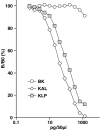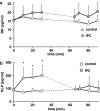A kallidin-like peptide is a protective cardiac kinin, released by ischaemic preconditioning of rat heart
- PMID: 16231012
- PMCID: PMC1751226
- DOI: 10.1038/sj.bjp.0706402
A kallidin-like peptide is a protective cardiac kinin, released by ischaemic preconditioning of rat heart
Abstract
Bradykinin is thought to play a major role among the endogenous cardioprotective candidates of ischaemic preconditioning (IPC). Little attention has been paid to the fact that in the tissue kallidin (KAL), rather than bradykinin might be the physiological mediator of the kallikrein-kinin system. In order to evaluate the importance of one or the other peptide the release and effect of both kinins has been investigated in isolated rat hearts following IPC. Bradykinin- and a KAL-like peptide were measured in the effluent of the rat isolated Langendorff heart with two different specific radioimmunoassays. The creatine kinase activity in the effluent was judged as degree of cardiac injury caused by ischaemia. During IPC, which consists of three 5 min no-flow and 5 min reperfusion cycles prior to the 30 min ischaemia, the bradykinin level in the effluent did not change significantly (15.4-19.4 pg ml(-1)). In the control group the bradykinin levels were 15.9-16.6 pg ml(-1). During IPC KAL-like peptide (Arg(1)-, instead of Lys(1)-KAL), which has recently been verified by mass spectrometry, displays 5.8-fold higher levels in the effluent and significantly increases in the same time interval from 90.4 to 189 pg ml(-1). After 30 min ischaemia the bradykinin levels in the IPC group were not significantly different to those of the control group (18.7 vs 14.4 pg ml(-1)). The KAL-like peptide levels in the IPC group vs the control group were 105 vs 86.1 pg ml(-1). By the 30 min ischaemia the creatine kinase activity in the IPC group increased from 0.367 to 8.93 U l(-1) (before and 10-30 min after ischaemia). In the control group during the same time period the creatine kinase levels increased from 0.277 to 34.9 U l(-1). The low increase in creatine kinase activity following IPC was taken as equivalent of the cardioprotective action. A KAL antibody or HOE140 (kinin B(2)-receptor antagonist) completely abolished this beneficial effect of IPC (36.6 and 53.0 U l(-1)) when added to the perfusion medium during the reperfusion cycles of IPC prior to the 30 min ischaemia. Our data suggest that in rat hearts KAL-like peptide rather than bradykinin is the physiological compound activated by IPC and acting via the cardiac kinin B(2)-receptor. Thus, endogenously generated KAL-like peptide seems to play a major role in the cardioprotection of IPC.
Figures





Similar articles
-
Kallidin-like peptide mediates the cardioprotective effect of the ACE inhibitor captopril against ischaemic reperfusion injury of rat heart.Br J Pharmacol. 2006 Jul;148(6):825-32. doi: 10.1038/sj.bjp.0706799. Epub 2006 Jun 12. Br J Pharmacol. 2006. PMID: 16770319 Free PMC article.
-
[Role of B1 receptors in the endothelial protective effect of ischaemic preconditioning].Arch Mal Coeur Vaiss. 1998 Aug;91(8):941-5. Arch Mal Coeur Vaiss. 1998. PMID: 9749141 French.
-
[Mechanism of cardioprotection against ischemia/reperfusion injury by valsartan: an experiment with isolated rat hearts].Zhonghua Yi Xue Za Zhi. 2005 Dec 14;85(47):3350-3. Zhonghua Yi Xue Za Zhi. 2005. PMID: 16409843 Chinese.
-
Cardioprotection and kallikrein-kinin system in acute myocardial ischaemia in mice.Clin Exp Pharmacol Physiol. 2008 Apr;35(4):489-93. doi: 10.1111/j.1440-1681.2008.04902.x. Clin Exp Pharmacol Physiol. 2008. PMID: 18307747 Review.
-
Towards understanding the kallikrein-kinin system: insights from measurement of kinin peptides.Braz J Med Biol Res. 2000 Jun;33(6):665-77. doi: 10.1590/s0100-879x2000000600008. Braz J Med Biol Res. 2000. PMID: 10829095 Review.
Cited by
-
Rat tissue kallikrein releases a kallidin-like peptide from rat low-molecular-weight kininogen.Br J Pharmacol. 2005 Dec;146(7):958-63. doi: 10.1038/sj.bjp.0706409. Br J Pharmacol. 2005. PMID: 16231010 Free PMC article.
-
Kallidin-like peptide mediates the cardioprotective effect of the ACE inhibitor captopril against ischaemic reperfusion injury of rat heart.Br J Pharmacol. 2006 Jul;148(6):825-32. doi: 10.1038/sj.bjp.0706799. Epub 2006 Jun 12. Br J Pharmacol. 2006. PMID: 16770319 Free PMC article.
-
Intermittent losartan administration triggers cardiac post-conditioning in isolated rat hearts: role of BK2 receptors.PLoS One. 2014 Feb 10;9(2):e88542. doi: 10.1371/journal.pone.0088542. eCollection 2014. PLoS One. 2014. PMID: 24520397 Free PMC article.
References
-
- BUGGE E., YTREHUS K. Bradykinin protects against infarction but does not mediate ischemic preconditioning in the isolated rat heart. J. Mol. Cell. Cardiol. 1996;28:2333–2342. - PubMed
-
- FENG J., ROSENKRANZ E.R. Bradykinin pretreatment improves ischemia tolerance of the rabbit heart by tyrosine kinase mediated pathways. Ann. Thorac. Surg. 1999;68:1567–1572. - PubMed
-
- GOTO M., LIU Y., YANG X.M., ARDELL J.L., COHEN M.V., DOWNEY J.M. Role of bradykinin in protection of ischemic preconditioning in rabbit hearts. Circ. Res. 1995;77:611–621. - PubMed
Publication types
MeSH terms
Substances
LinkOut - more resources
Full Text Sources
Research Materials
Miscellaneous

